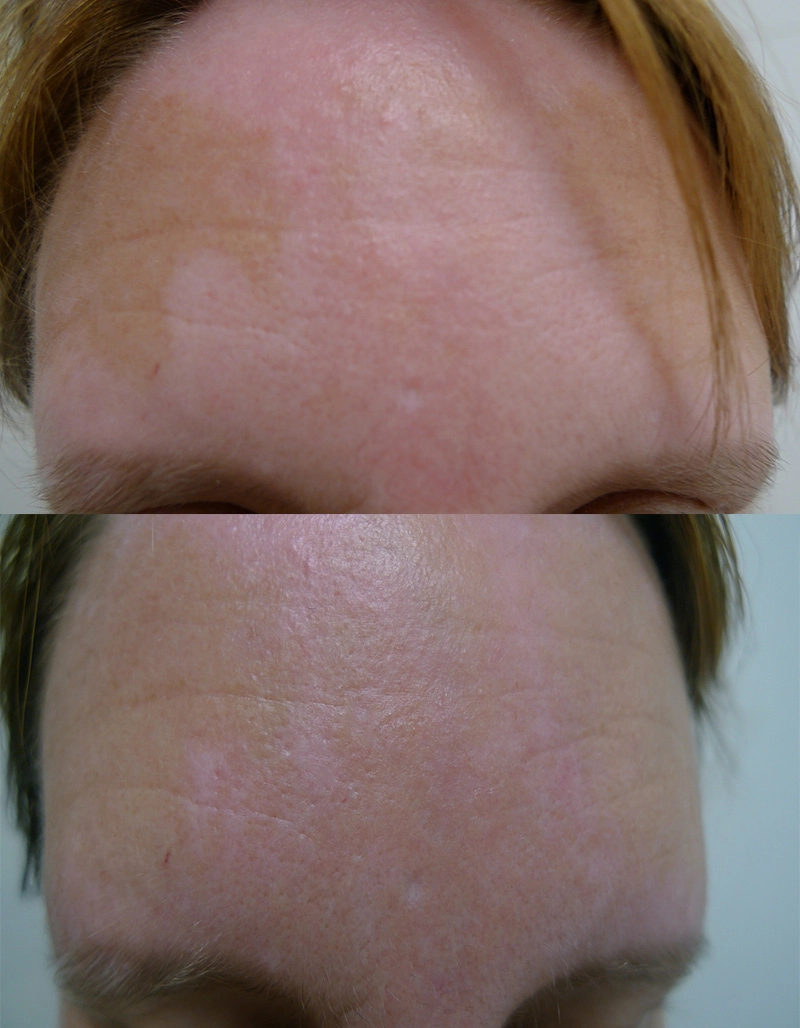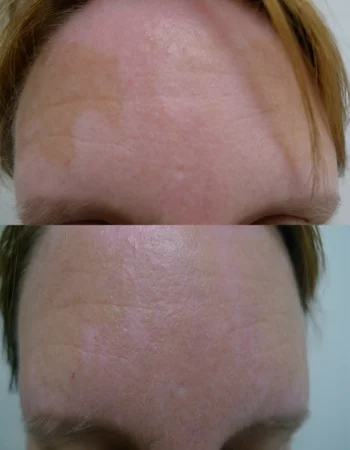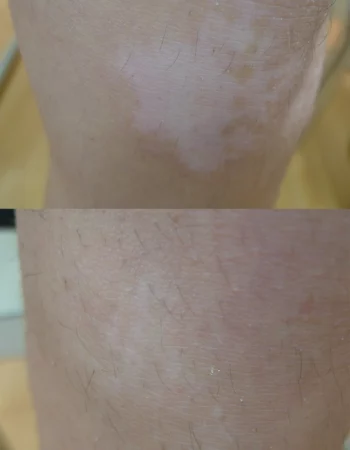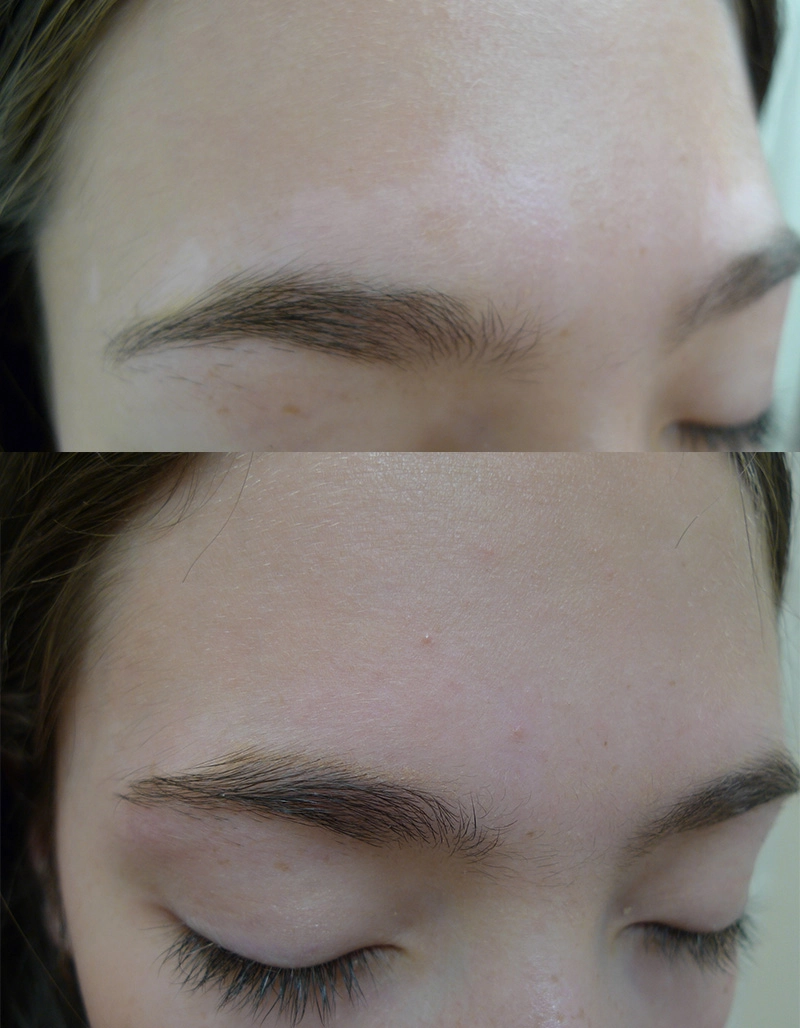Pigment transfer is the best way to recolour areas of vitiligo that are resistant to normal treatment. This involves taking pigment cells from normal skin to the areas involved in vitiligo. The success rate of this procedure is over 90%.
Key Points
- Vitiligo surgery is reserved for cases that don’t respond to normal treatment
- You must have stable vitiligo for at least 6-9 months before surgery is considered
- Up to one palm surface area can be treated in one session
- Pigmentation is seen at one week & is maximal at 12 months
- This procedure is partially covered by Medicare
Vitiligo Surgery at a glance
Our results speak for themselves

Before
After

Pigment stimulators & phototherapy
Ask us more about this treatmant
Preferred Consultation

Before
After

Pigment stimulators & phototherapy
Ask us more about this treatmant
Preferred Consultation

Before
After

Pigment stimulators & phototherapy
Ask us more about this treatmant
Preferred Consultation
FAQs
What does surgical treatment of vitiligo entail?
The surgical treatment of choice is free hand micrografting. This transfers pigment cells from normal skin to white areas of vitiligo.
Once transferred these pigment cells produce melanin, this results in re-pigmentation in the affected areas. Surgical repurposing of melanocytes gives the fastest response as results are seen at one week.
How long before I see the results?
You can see changes as early as 5-7 days. Maximal results can take up to 6-12 months, depending on the surface area treated. The time is as follows-
- Recipient site healing: one week
- Repigmentation: patchy for first 4 months, increases over 12 months
- Donor site (area where pigment cells are taken): heals over 4-6 weeks
What is involved in surgery?
It’s a complex procedure & goes something like this-
- Donor site harvesting under local anaesthesia. Ultra-thin free hand split harvest.
- Recipient site preparation with dermabrasion or erbium.
- Transfer of micrograft to prepared site.
- Dressings left in-situ for one week
- Repigmentation.
Dermatologists follow strict guidelines for surgery as this is last line management, read more to see if you are a suitable candidate.
Are the results permanent?
Yes, they can be lifelong. This is providing your vitiligo is stable. We can’t promise you will not get new patches elsewhere. In 95% of cases pigment transfer is permanent in the sites treated with surgery.
Who is not suitable for pigment transfer?
You are not a candidate if –
- Your vitiligo is not stable for more than 9 months to one year. For new onset vitiligo, you are best treated with narrowband UV & topical creams.
- Your vitiligo has Koebner or worsens with trauma.
- Children under the age of 14.
- You have a history of keloid scarring.
How do I know if surgery is the treatment of choice for me?
Book a consultation with our dermatologists at Cutis. They will examine your skin & advise you accordingly.
What areas of vitiligo can be treated with surgery?
We treat any area, bar the genitals. Frequently treated areas include-
- Face including eyelids
- Hands
- Feet
- Neck
- Lips
Poliosis or white hairs can be repigmented with this technique or better yet, follicular unit transplantation, or FUE.
What medical therapy should you try before surgery for vitiligo?
Medical therapy with creams & narrowband phototherapy can re-pigment over 80% of vitiligo cases. This should be tried prior to surgery. Our standard re-pigmentation protocol is as follows-
Creams: Pigment stimulatory creams include vitamin D, anti-inflammatory creams & calcineurin inhibitors used in a cyclical manner.
Phototherapy: narrowband UVB (Medicare covered).
Consider: Vitamin D supplementation, ginkgo biloba supplementation.
The only type of vitiligo that can do straight to surgical treatment is segmental vitiligo. This subtype has little, if not no chances of re-pigmentation as there are no melanocytes in the area since birth/early childhood.
What is phototherapy & why is it important?
Phototherapy is an essential step in the management of vitiligo as it stimulates the pigment cells (melanocytes) to produce pigment & to migrate. Phototherapy –
- Take 1-3 minutes to perform
- 2-3 sessions per week
- Has a long safety record
- Is fully covered under Medicare
Most patients undergo a series of sessions after surgery as this amplifies re-pigmentation.
What are other treatment options for vitiligo?
We base treatment on the type of vitiligo, age of patients, the duration of de-pigmentation, your skin type, previous treatments & your end goals as well as insurance cover. Treatments include-
- Creams: are useful if you have viable pigment cells. They reduce inflammation & stimulate pigment. The type of cream depends on the location & surface area involved.
- Phototherapy: is the gold standard. This is covered under Medicare. Narrowband suppresses inflammation & awakens melanocytes.
- Lasers: Include fractional & excimer laser 308. They are useful in research, they are less useful in clinical practice. They are not covered under Medicare.
Diet: avoiding acidic foods & gluten can help. Dieting is harmless, so if you want to commence, go ahead. We support you.
Do I need to use creams after surgery?
No, but it is advisable. Dermatologists will prescribe you pigment migratory creams after surgery. This, together with phototherapy results in faster gains & a more even colouration of vitiligo areas.
Vitamin D has been shown to increase pigment via increased migration of pigment cells. We prefer creams; however, you can supplement with vitamin D tablets (if it helps your psychologically).
Products

O Cosmedics cleansing range
$63.00-$64.00

O Biotics 3D Hyaluronic Serum
From $97.00
Surgical therapies including ReCell & pigment transfer can be considered in cases of recalcitrant stable vitiligo. Our dermatologists have extensive experience in this procedure.
Is diet important post-surgery?
Not as much as topical creams & phototherapy. You can go on a diet if that helps you psychologically. A vitiligo diet consists of –
- Eating antioxidant rich foods such as fish, nuts, green leafy vegetables
- Refraining from acidic foods like tomatoes
Diet does not add much to your progression & result, but it is harmless.
How does this procedure compare to ReCell?
ReCell is best for large area BURNS. It can partially re-pigment vitiligo however the results are not as good as micrografting. ReCell costs more, & harvests less viable pigment cells as most are lost in the process.
Our dermatologists have had over 10 years of experience using this method, & we prefer free hand micrografting for vitiligo.
What are the side effects of vitiligo surgery?
Side effects are rare & must be differentiated from expected healing. The biggest side effect is vitiligo progression post-surgery. This means vitiligo recurs at both the recipient or treated area & the donor site.
Other side effects include-
- Scarring in donor site
- Marked cobble stoning in vitiligo recipient site
- Infection
- Delayed healing
How much does it cost?
Surgical treatment is partially covered under Medicare. Cost depends on the treatment area.
- Narrowband UVB- Bulk Billed, no charge
- Creams are less than $1.90 per day
What is a mesh graft?
Mesh grafting for vitiligo is of historical value only as it is not widely performed in current times. This technique is a way of expanding the surface area of split-thickness grafts.
The reason it is not used is that this graft has too many gaps between the network, meaning vitiligo re-pigmentation is patchy.
What are full thickness punch grafts for vitiligo?
Much like mesh, punch grafts are seldom used. This is a full thickness graft as compared to split grafting. Full thickness grafts will result in cobble stoning of the recipient site.
Punch grafting is also limited to surface area. Only small patches of vitiligo can be treated.
What are suction blister grafts for vitiligo?
This old technique was used by dermatologists to harvest a very thin layer of melanocytes. Suction causes the upper layer of skin to separate from the lower dermis. This type of grafting has less cobble stoning compared to full thickness grafting.
Suction blister grafting is time consuming; the results are mediocre, & not as even distributed compared to free hand grafting.
What must you consider before contemplating grafting surgery for vitiligo?
This is an investment of your time, effort & money. We are very careful in who we perform surgical procedures for, as we want the best outcomes. You must consider the following-
- Stability of vitiligo: Surgery is only contemplated if your vitiligo is stable for a minimum of 6 months. If you have unstable vitiligo, we will not treat this with surgery.
- Previous treatments: Topicals & narrowband are far more cost effective & side effect free compared to surgery. Have you tried it yet?
- Age of patient: We will not graft patients under the age of 15.
- Surface area involved: One to two palm areas at a time.
- Time frame: It can take up to 1 year for best results.
- Insurance cover: This treatment is covered in Australia under Medicare. If you do not have Medicare factor in the costs of surgery, around $2,990. Phototherapy costs range from $4990 to $7990 per year. The latter is fully covered in Australia under Medicare.


